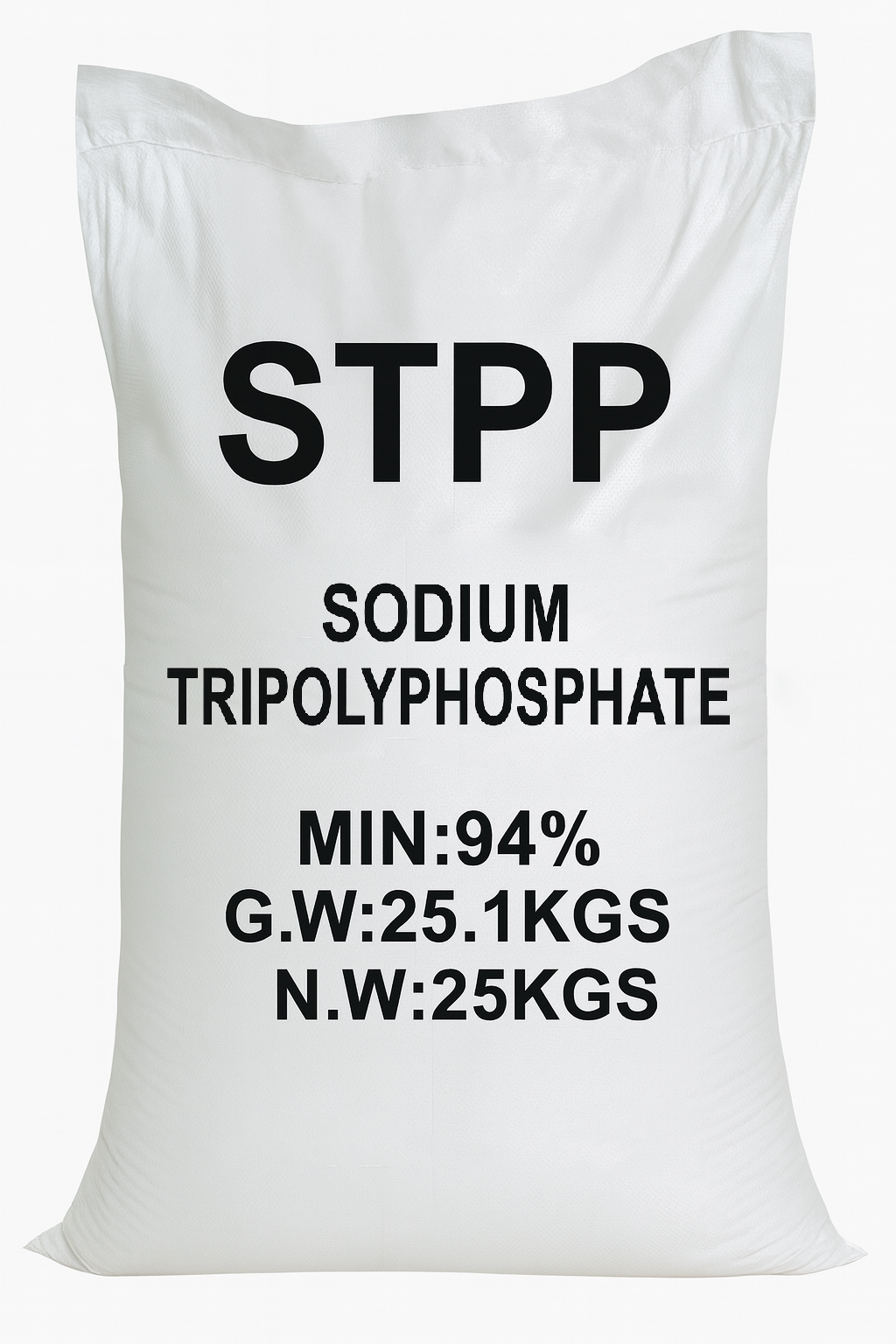STPP - sodium three poly phosphate
Sodium Tripolyphosphate (STPP), also known as Sodium Triphosphate, is an inorganic compound with the chemical formula Na₅P₃O₁₀. It is widely used in various industries due to its excellent properties as a cleaning agent, water softener, and dispersing agent. STPP is a white, granular or crystalline powder that dissolves easily in water and is commonly used in applications such as detergents, ceramics, food preservation, and water treatment.
Chemical Composition and Structure:
Chemical Formula: Na₅P₃O₁₀
Molecular Weight: 367.86 g/mol
Appearance: White crystalline powder or granules
Solubility: Highly soluble in water
STPP is made up of three phosphate groups linked together and five sodium ions, giving it strong chelating (binding) properties, which allows it to sequester metal ions, particularly calcium and magnesium, in water. This makes it an effective water softener.
Key Properties of STPP:
Sequestering and Chelating Ability:
STPP has excellent ability to chelate or bind to metal ions such as calcium, magnesium, and iron. This property helps prevent the formation of insoluble metal salts in water and enhances the effectiveness of detergents by softening water.
Dispersing Agent:
It acts as a dispersing agent, helping to suspend dirt and particles in solution, preventing them from redepositing on surfaces or fabrics. This property is crucial in cleaning applications.
Buffering Capacity:
STPP has good buffering properties, allowing it to maintain a stable pH in a variety of solutions, which is useful in detergents and cleaning products that need to function over a range of conditions.
Water Softening:
By sequestering calcium and magnesium ions, STPP prevents these minerals from interfering with cleaning processes. This helps improve the performance of soaps and detergents, particularly in hard water areas.
Hydrotropic Action:
STPP can enhance the solubility of certain compounds, improving the overall cleaning efficiency of detergent formulations.
Applications of Sodium Tripolyphosphate (STPP):
Detergents and Cleaning Agents:
Laundry Detergents: STPP is widely used in laundry powders and liquid detergents due to its ability to soften water, allowing detergents to work more effectively by preventing the formation of soap scum. It helps improve the cleaning performance, particularly in hard water.
Dishwashing Detergents: It is used in automatic dishwashing detergents to reduce spotting and filming by controlling calcium deposits.
Surface Cleaners: It is included in household and industrial cleaning products where its chelating properties help remove dirt, oil, and mineral deposits from surfaces.
Ceramic Industry:
Ceramic Processing: STPP is used as a dispersing agent in the production of ceramic materials, helping to break up and suspend fine ceramic particles in water. This improves the stability and consistency of ceramic slurries used in tile and porcelain manufacturing.
Tile and Porcelain Glazing: It helps to improve the flow and smoothness of glazes applied to tiles or porcelain, ensuring even application.
Water Treatment:
Scale Inhibition: In industrial water treatment, STPP is used to prevent scale formation by sequestering calcium and magnesium ions. This ensures that the water systems remain free of mineral buildup that could otherwise clog pipes and reduce efficiency.
Corrosion Control: In addition to preventing scaling, STPP helps in controlling corrosion in water systems by stabilizing metals and maintaining water chemistry.
Food Industry (as a Food Additive):
Preservative: In the food industry, STPP is used as a preservative, emulsifier, and stabilizer. It helps retain moisture in processed meats, seafood, and poultry, improving texture and appearance. For example, it prevents the meat from drying out during freezing and thawing.
Food Grade STPP: It is designated as E451 in the European Union and is used in the preservation of foods like canned meats, seafood, and cheeses.
Textile Industry:
STPP is used in the textile industry during the scouring and bleaching processes to improve the cleaning and softness of textiles. Its chelating ability helps in removing unwanted metal ions that could interfere with dyeing and fabric quality.
Oil Drilling:
In oil drilling, STPP is used as a dispersing agent in muds and drilling fluids to prevent clay and other particles from settling, helping to maintain the flow and consistency of drilling operations.
Paints and Coatings:
As a dispersant, STPP helps improve the uniformity and stability of paint formulations by preventing the settling of pigments and improving the flow characteristics of the paint.
Advantages of Using STPP:
Enhances Cleaning Efficiency:
By softening water and dispersing particles, STPP significantly improves the efficiency of cleaning agents, making them more effective at removing dirt, stains, and grease.
Prevents Scale Formation:
STPP prevents the buildup of scale in industrial water systems and household appliances, leading to increased efficiency and longer lifespan of equipment.
Improves Product Quality:
In the food and ceramics industries, STPP plays a key role in improving the texture, stability, and overall quality of products, whether it's retaining moisture in processed foods or stabilizing ceramic glazes.
Cost-Effective:
STPP is a relatively inexpensive compound that offers multiple benefits in various industries, from cleaning to food processing, making it a valuable and cost-effective ingredient.
Environmental Concerns and Regulations:
While STPP is highly effective in industrial and commercial applications, its use has raised environmental concerns, particularly due to its role in eutrophication. When large amounts of phosphates like STPP enter water bodies, they can promote the excessive growth of algae, leading to depletion of oxygen in the water and negatively affecting aquatic ecosystems.
As a result, there has been increasing regulation of phosphate-based products, particularly in household detergents, in several regions around the world. Many companies have started to reduce or eliminate the use of phosphates in detergents to address environmental concerns, replacing STPP with more eco-friendly alternatives.
